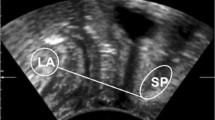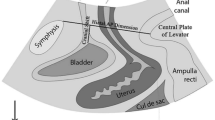Abstract
Introduction and hypothesis
Transabdominal (TA) ultrasound and perineometry have been currently used to assess lifting aspect and squeezing action of pelvic floor muscles (PFM) function, respectively, in women with stress urinary incontinence (SUI). However, no study has directly compared these measurements. The purpose of this study was to investigate the reliability and correlation between perineometry and TA ultrasound as measurements of different aspect of PFM function.
Methods
A total of 28 women with SUI participated in the study. Vaginal squeeze pressure using a perineometer and bladder base movement on TA ultrasound was measured. Scattergram was depicted to determine the correlation between variables. Intraclass correlation coefficient and Bland–Altman plot were used to assess reliability.
Results
Scatter diagram depicted significant correlation of TA ultrasound with vaginal squeeze pressure (r = 0.72, R 2 = 0.52, p < 0.0001). High reliability was found for measurements.
Conclusion
TA ultrasound measurement may be an alternative measurement to perineometry when assessing PFM function.


Similar content being viewed by others
References
Bø K, Sherburn M (2005) Evaluation of female pelvic-floor muscle function and strength. Phys Ther 85:269–282
Sapsford R, Hodges P (2001) Contraction of the pelvic floor muscles during abdominal manoeuvers. Arch Phys Med Rehabil 82:1081–1088
Amro J, Gameiro M, Padovani C (2003) Treatment of urinary stress incontinence by intravaginal electrical stimulation and pelvic floor physiotherapy. Int Urogynecol J Pelvic Floor Dysfunct 14:204–208
Bø K (2003) Pelvic floor muscle strength and response to pelvic muscle training for stress urinary incontinence. Neurourol Urodyn 22:654–658
Dumoulin C, Hay-Smith J (2008) Pelvic floor muscle training versus no treatment for urinary incontinence in women. A Cochrane systematic review. Eur J Phys Rehabil Med 44:47–63
Isherwood PJ, Rane A (2000) Comparative assessment of pelvic floor strength using a perineometer and digital examination. BJOG 107:1007–1011
Bø K, Finckenhagen HB (2001) Vaginal palpation of pelvic floor muscle strength: inter-test reproducibility and comparison between palpation and vaginal squeeze pressure. Acta Obstet Gynecol Scand 80:883–887
Morin M, Dumoulin C, Bourbonnais D, Gravel D, Lemieux M (2004) Pelvic floor maximal strength using vaginal digital assessment compared to dynamometric measurements. Neurourol Urodyn 23:336–341
Hundley AF, Wu JM, Visco AG (2005) A comparison of perineometer to brink score for assessment of pelvic floor muscle strength. Am J Obstet Gynecol 192:1583–1591
Kegel A (1948) Progressive resistance exercise in the functional restoration of the perineal muscles. Am J Obstet Gynecol 56:238–249
Frawley H, Galea M, Phillips B, Sherburn M, Bø K (2006) Effect of test position on pelvic floor muscle assessment. Int Urogynecol J Pelvic Floor Dysfunct 17:365–371
Uyar Y, Baytur YB, Inceboz U (2007) Perineometer and digital examination for assessment of pelvic floor strength. Int J Gynaecol Obstet 98:64–65
Thompson JA, O’Sullivan PB, Briffa NK, Neumann P, Court S (2005) Assessment of pelvic floor movement using transabdominal and transperineal ultrasound. Int Urogynecol J Pelvic Floor Dysfunct 16:285–292
Thompson JA, O’Sullivan PB, Briffa NK, Neumann P (2007) Comparison of transperineal and transabdominal ultrasound in the assessment of voluntary pelvic floor muscle contractions and functional manoeuvres in continent and incontinent women. Int Urogynecol J Pelvic Floor Dysfunct 18:779–786
Sherburn M, Murphy CA, Carroll S, Allen TJ, Galea MP (2005) Investigation of transabdominal real-time ultrasound to visualize the muscles of the pelvic floor. Aust J Physiother 51:167–170
Kelly M, Tan BK, Thompson J, Carroll S, Follington M, Arndt A et al (2007) Healthy adults can more easily elevate the pelvic floor in standing than in crook-lying: an experimental study. Aust J Physiother 53:187–191
Bø K, Sherburn M, Allen T (2003) Transabdominal ultrasound measurement of pelvic floor muscle activity when activated directly or via a transversus abdominis muscle contraction. Neurourol Urodyn 22:582–588
Thompson J, O’Sullivan P, Briffa NK, Court S (2003) A comparison between transabdominal and transperineal ultrasound in the assessment of women performing pelvic floor exercises. Aust N Z Continence 9:92–93
Dietz HP, Jarvis SK, Vancaillie TG (2002) The assessment of levator muscle strength: a validation of three ultrasound techniques. Int Urogynecol J Pelvic Floor Dysfunct 13:156–159
Thompson JA, O’Sullivan PB, Briffa NK, Neumann P (2006) Assessment of voluntary pelvic floor muscle contraction in continent and incontinent women using transperineal ultrasound, manual muscle testing and vaginal squeeze pressure measurements. Int Urogynecol J Pelvic Floor Dysfunct 17:624–630
Abrams p, Cardozo L, Fall M, Griffiths D, Rosier P, Ulmsten U (2003) The standardisation of terminology in lower urinary tract function: report from the standardisation sub-committee of the international continence society. Urology 61:37–49
Ishiko O, Hirai K, Sumi T, Nishimura S, Ogita S (2000) The urinary incontinence score in the diagnosis of female urinary incontinence. Int J Gynaecol Obstet 68:131–137
Bø K, Kvarstein B, Hagen R, Larsen S (1990) Pelvic floor muscle exercise for the treatment of female stress urinary incontinence: II. Validity of vaginal pressure measurements of pelvic floor muscle strength and the necessity of supplementary methods for control of correct contraction. Neurourol Urodyn 9:479–487
Bump R, Mattiasson A, Bi K et al (1996) The standardization of terminology of female pelvic organ prolapse and pelvic floor dysfunction. Am J Obstet Gynecol 175:10–17
Bower FW, Chase JW, Stillman BC (2006) Normative pelvic floor parameters in children assessed by transabdominal ultrasound. J Urol 176:337–341
Peschers UM, Gingelmaier A, Jundt K, Leib B, Dimpfl T (2001) Evaluation of pelvic floor muscle strength using four different techniques. Int Urogynecol J Pelvic Floor Dysfunct 12:27–30
Acknowledgment
The authors would like to acknowledge the staff of the physiotherapy department at the University of Social Welfare and Rehabilitation Sciences for their cooperation.
Conflicts of interest
None.
Author information
Authors and Affiliations
Corresponding author
Additional information
This research was reviewed and approved by the Human Subject Committee at University of Social Welfare and Rehabilitation Sciences.
Rights and permissions
About this article
Cite this article
Chehrehrazi, M., Arab, A.M., Karimi, N. et al. Assessment of pelvic floor muscle contraction in stress urinary incontinent women: comparison between transabdominal ultrasound and perineometry. Int Urogynecol J 20, 1491–1496 (2009). https://doi.org/10.1007/s00192-009-0977-8
Received:
Accepted:
Published:
Issue Date:
DOI: https://doi.org/10.1007/s00192-009-0977-8




